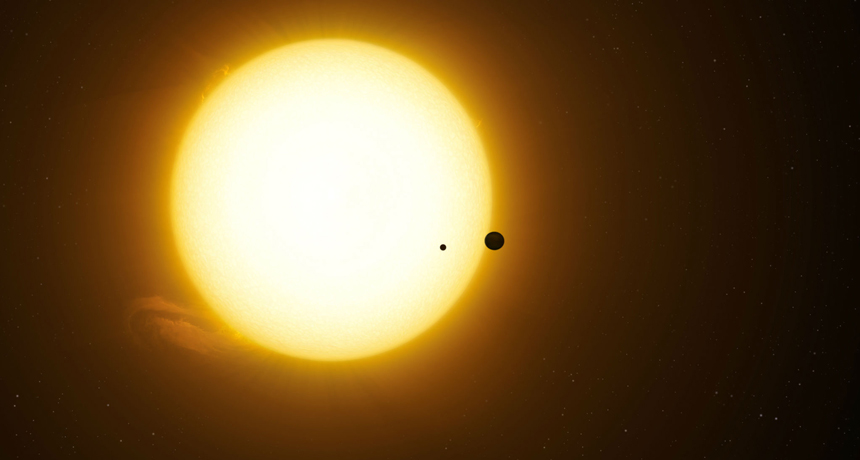Hubble may have spotted a possible ‘exomoon’
Unusually large, the moon tests theories on how such orbs form

The Hubble Space Telescope may have spotted a Neptune-sized moon orbiting a Jupiter-sized planet, as shown in this illustration.
Dan Durda
There may be a moon the size of Neptune far out in space. It appears to be orbiting a planet in another solar system. Such planets are known as exoplanets. So its moon would be exomoon. If it exists, this orb would challenge ideas of how moons are born.
David Kipping and Alex Teachey spotted signs of the exomoon with the Hubble Space Telescope. Both astronomers work at Columbia University in New York City. The pair pointed the telescope on the star Kepler 1625. Then it watched the star for 40 hours on October 28 and 29, 2017. Earlier, the Kepler space telescope had shown this star had a Jupiter-sized planet. It orbited its sun every 287 days. Scientists spotted the planet from dips in starlight reaching the telescope. Those dips were a darkening of starlight as the planet transited — passed in front of — the star.
But Teachey and Kipping saw something else in the Kepler data: signs of a second dimming. It happened either before or after the planet’s transit. And that second dimming is exactly what astronomers would expect if an exomoon were orbiting the planet.
The astronomers named this possible moon Kepler 1625b i. Informally, they call it Neptmoon. But there was always the chance it could simply be another planet. Or the dimming might reflect some activity on the star. To be sure it really was a moon, the researchers needed more data.
That’s why they turned to Hubble. It is 3.8 times more sensitive to dips in light than Kepler is.
And Hubble also spotted the secondary dip in light after the planet’s 19 hour transit of its star. That transit started 77.8 minutes earlier than expected. This suggested something was tugging gravitationally on the planet. Kipping, Teachey and colleagues reported their finding October 3 in Science Advances.
Both the dip in light and the early transit are consistent with there being a Neptmoon. Still, “we’re not cracking open champagne bottles just yet,” Teachey said in an Oct. 1 news conference. His team wants to check with Hubble again. Teachey said they might try in May 2019. That’s the next time the planet transits Kepler 1625.
René Heller is an astrophysicist at the Max Planck Institute for Solar System Research in Göttingen, Germany. He finds the new analysis of the transit data impressive. Still, he says, “I remain skeptical” that the exomoon exists. He, too, wants to see another transit and better observations of the star.
One reason to be cautious about the new data is how a moon as large as this one would form. In our solar system, moons have formed in only three ways. Some are knocked out of the body of a planet by an impact. Others form from gas and rock orbiting a planet. A moon might also be grabbed by the planet’s gravity. None of scenarios, however, should result in a moon as large as the new apparent exomoon.
“Kepler 1625b i, if real, would be about 10 times as massive as the mass of all moons and terrestrial planets in [our] solar system combined,” says Heller. “This suggests that this moon would have formed in a completely different way.”







